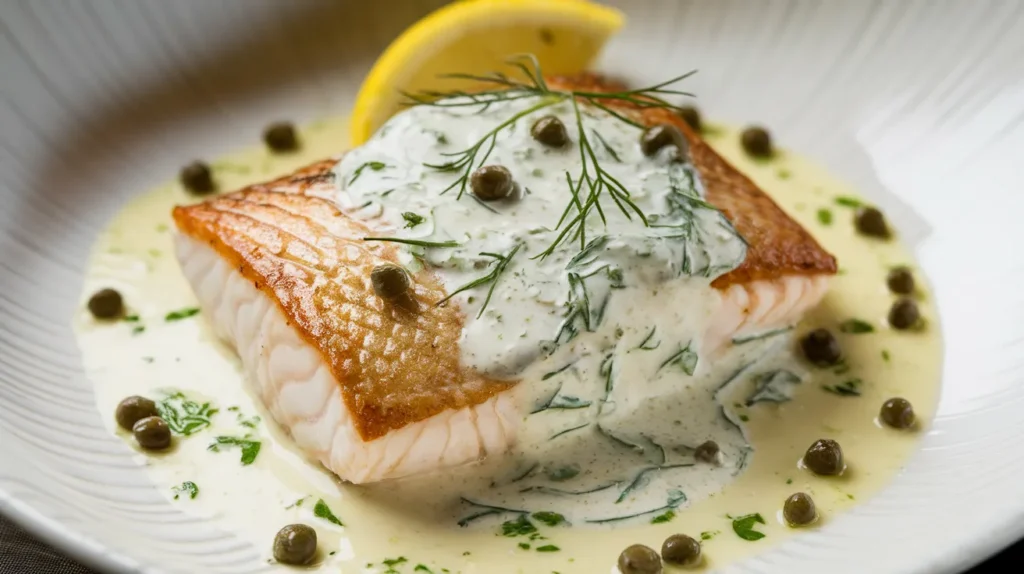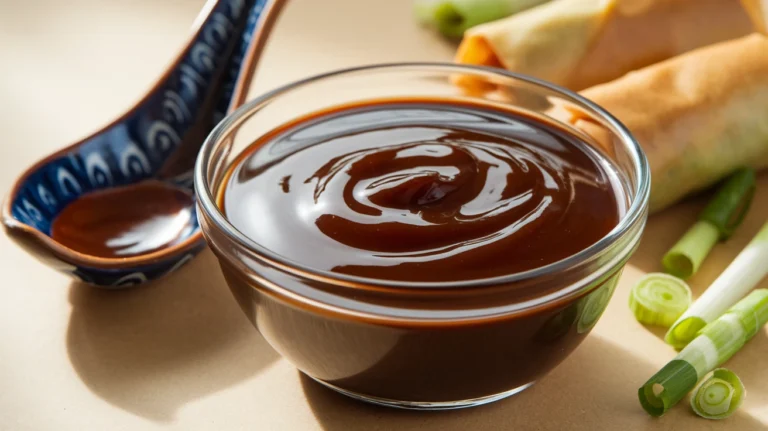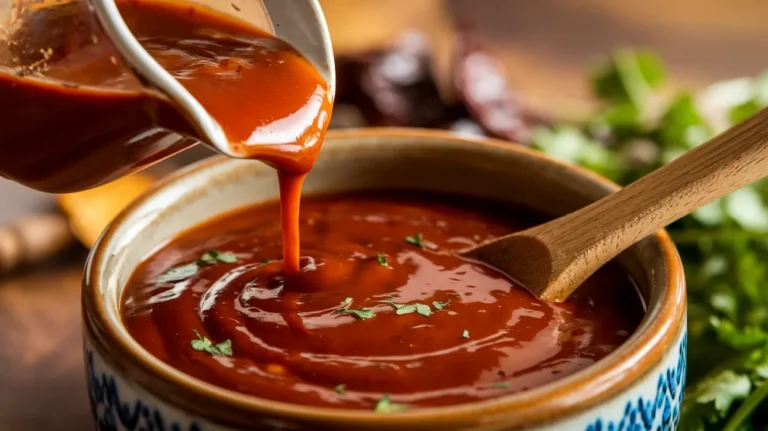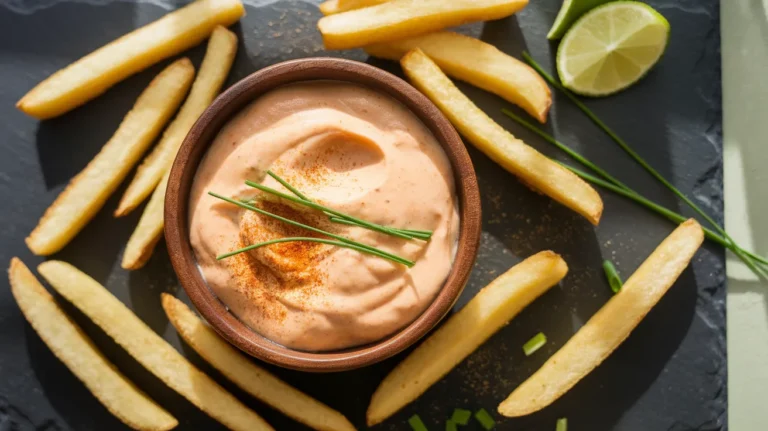This luxurious sauce for haddock fish creates an elegant dinner that’s surprisingly simple to master. Our step-by-step sauce for haddock fish recipe walks beginners through every detail, from perfectly seared fillets to a velvety cream sauce that rivals fine dining restaurants.
Recipe Info Bar
SERVES: 4 | PREP: 15 MIN | COOK: 12 MIN | TOTAL: 27 MIN
Ingredients
For the Haddock
| Ingredient | Amount |
|---|---|
| Fresh haddock fillets | 4 pieces (6 oz each) |
| All-purpose flour | 1/2 cup |
| Salt | 1 teaspoon |
| Black pepper | 1/2 teaspoon |
| Olive oil | 2 tablespoons |
For the Sauce
| Ingredient | Amount |
|---|---|
| Unsalted butter | 4 tablespoons |
| Fresh lemon juice | 3 tablespoons |
| White wine | 1/4 cup |
| Heavy cream | 1/3 cup |
| Fresh dill | 2 tablespoons, chopped |
| Fresh parsley | 2 tablespoons, chopped |
| Garlic | 2 cloves, minced |
| Capers | 1 tablespoon |
Complete Step-by-Step Instructions for Sauce for Haddock Fish
Phase 1: Fish Preparation (8 minutes)
- Remove fish from refrigerator 15 minutes early. Room temperature fish cooks more evenly than cold fillets straight from the fridge. Place fillets on a plate and cover loosely with plastic wrap. This prevents the outside from cooking too quickly while the center remains cold.
- Examine each haddock fillet carefully. Look for any remaining bones by running your fingers along the flesh. Haddock typically has few bones, but removing any you find prevents an unpleasant dining experience. Use tweezers or needle-nose pliers to pull out bones in the direction they’re pointing.
- Pat fillets completely dry with paper towels. Press firmly but gently to absorb all surface moisture. Wet fish will steam instead of sear, preventing the golden crust that makes this sauce for haddock fish recipe so appealing. Replace paper towels if they become too damp.
- Create your seasoned flour mixture. In a wide, shallow dish (like a pie plate), combine flour, salt, and pepper. Use a fork to mix thoroughly, ensuring even distribution. This coating helps the fish develop a beautiful golden exterior and provides texture contrast to the smooth sauce.
- Set up your dredging station. Place the seasoned flour dish next to your workspace. Have a clean plate ready for the coated fillets. Keep one hand designated for handling raw fish and the other for touching clean surfaces – this prevents cross-contamination.
- Dredge each fillet individually. Hold the fillet by one end and lay it in the flour mixture. Use your clean hand to sprinkle flour over the top, then gently turn the fillet to coat both sides. Shake off excess flour by lifting the fillet and gently tapping it. Too much flour creates a gummy coating that masks the fish’s delicate flavor.
Phase 2: Cooking the Haddock (10 minutes)
- Heat your skillet properly. Place a large (12-inch if possible) non-stick or stainless steel skillet over medium-high heat. Add olive oil and swirl to coat the bottom evenly. The oil is ready when it shimmers and moves freely across the pan – this usually takes 2-3 minutes.
- Test the oil temperature. Drop a tiny pinch of flour into the oil. If it sizzles immediately but doesn’t smoke, your temperature is perfect (around 350°F). If there’s no sizzle, wait another minute. If it smokes, reduce heat slightly and let it cool for 30 seconds.
- Add fish to the pan carefully. Place each fillet in the pan away from your body to prevent oil splatter. Lay the prettiest side down first – this will be your presentation side. Don’t move or adjust the fillets once they’re in the pan. The sizzling should be active but not violent.
- Watch for visual cues while the first side cooks. After 2-3 minutes, you’ll notice the edges of the fish beginning to turn opaque (white). This opacity will slowly creep up the sides. The bottom should be developing a golden-brown crust. Resist the urge to peek underneath – the fish will release naturally when ready.
- Check doneness of the first side. After 3-4 minutes, gently lift one corner of a fillet with a thin spatula. Look for a golden-brown color. If it’s pale, cook another minute. If it’s dark brown, your heat is too high for the remaining fillets.
- Flip the fillets with confidence. Slide your spatula completely under each fillet and flip in one smooth motion. The cooked side should be beautifully golden. If any fillet sticks, it’s not ready to flip yet – give it another 30 seconds.
- Cook the second side to perfection. The second side typically cooks faster (2-3 minutes) since the pan is now very hot. Watch for the flesh to become completely opaque throughout. When pressed gently with your finger, the fish should feel firm but still give slightly.
- Check internal temperature for food safety. Insert an instant-read thermometer into the thickest part of the largest fillet. It should read 145°F for safe consumption. The fish will also flake easily when tested with a fork.
- Remove fish and keep warm. Transfer all fillets to a warm plate and tent loosely with aluminum foil. Don’t seal the foil tightly or the fish will continue cooking from trapped steam. The residual heat will keep them warm while you make the sauce.
Phase 3: Creating the Perfect Sauce for Haddock Fish Base (6 minutes)
- Reduce heat immediately. Lower your burner to medium heat. The pan will be very hot from cooking the fish, so this prevents the garlic from burning in the next step.
- Add garlic with careful timing. Add minced garlic directly to the hot pan (no need to add more oil – the residual oil from cooking fish is sufficient). Stir constantly with a wooden spoon for 30-60 seconds. The garlic should become fragrant and just barely golden. If it turns brown, it will taste bitter.
- Deglaze with white wine. Pour the wine into the pan all at once – it will bubble vigorously. This is normal and desired. Use your wooden spoon to scrape up all the browned bits from the bottom of the pan. These fond pieces add incredible depth to your sauce for haddock fish.
- Reduce the wine properly. Let the wine simmer actively for 2-3 minutes. You’ll hear the bubbling become less intense as the liquid reduces. The wine should reduce by approximately half, concentrating the flavors and cooking off most of the alcohol. You’ll know it’s ready when you can draw a line through the liquid with your spoon and it fills in slowly.
Phase 4: Building the Creamy Sauce for Haddock Fish (8 minutes)
- Add cream at the right temperature. Pour heavy cream into the reduced wine mixture. The pan should be at medium heat – not too hot or the cream might curdle. Stir gently to combine with the wine reduction.
- Bring to a gentle simmer. Increase heat slightly if needed to achieve a gentle simmer. You want small bubbles around the edges, not a rolling boil. A rolling boil can cause the cream to separate and ruin the sauce texture.
- Monitor the cream carefully. Simmer for 2-3 minutes, stirring occasionally. The cream will begin to thicken slightly as it reduces. If you notice any curdling (lumpy appearance), immediately remove from heat and whisk vigorously.
- Incorporate butter for richness. Remove the pan from heat temporarily. Add cold butter one tablespoon at a time, whisking constantly after each addition. This technique, called mounting, creates a silky, restaurant-quality texture. Don’t rush this step – each piece should be nearly melted before adding the next.
- Add lemon juice gradually. Start with 2 tablespoons of fresh lemon juice, whisking it in completely. Taste the sauce (use a clean spoon each time) and add the remaining tablespoon if you want more brightness. Too much acid at once can cause the cream to break.
- Finish with fresh herbs and capers. Remove the pan from heat completely. Stir in chopped dill, parsley, and capers. Fresh herbs lose their potency quickly when overheated, so this timing preserves their bright flavor that makes this sauce for haddock fish so special.
Phase 5: Final Assembly and Service (3 minutes)
- Taste and adjust your sauce. Use a clean spoon to taste the sauce. It should be creamy, bright from the lemon, and herbaceous. Adjust with salt, white pepper, or additional lemon juice as needed. Remember, you can always add more but you can’t take it away.
- Warm the fish gently. If your haddock has cooled, return the fillets to the pan with the sauce for just 30 seconds per side. Don’t let them cook further – you’re just warming them through.
- Serve immediately for best results. Transfer each fillet to individual plates and spoon the warm sauce for haddock fish generously over the top. Serve within 2-3 minutes while everything is at optimal temperature.
Chef’s Notes for Perfect Sauce for Haddock Fish
• Temperature control is your best friend – this sauce for haddock fish requires gentle heat throughout the sauce-making process to maintain its silky texture.
• Fresh herbs are non-negotiable – dried herbs simply cannot provide the bright, clean flavors that make this sauce for haddock fish restaurant-worthy.
• Wine substitution works perfectly – replace white wine with extra lemon juice plus chicken broth for an alcohol-free sauce for haddock fish.
• Timing matters most – have all ingredients prepped before you start cooking since this sauce for haddock fish comes together quickly once you begin.
Nutrition Box (Per Serving)
- Calories: 385
- Protein: 36g
- Carbs: 8g
- Fat: 22g
- Sodium: 485mg
Creative Variations of Sauce for Haddock Fish
Mediterranean Style
Replace dill with fresh oregano and add sun-dried tomatoes. This variation pairs beautifully with our sauce for grilled salmon techniques.
Asian Fusion
Substitute soy sauce for capers and add fresh ginger instead of herbs for an umami-rich twist.
Spicy Cajun Version
Include paprika, cayenne, and hot sauce in the flour mixture, then finish with green onions instead of herbs.
Light Herb Sauce
Use Greek yogurt instead of heavy cream and double the fresh herbs. This lighter approach works wonderfully with our sauce for halibut fish recipe too.
Storage & Reheating Your Sauce for Haddock Fish
Refrigerate leftover sauce up to 3 days in airtight container. The cream base may separate slightly but whisks back together when reheated gently.
Reheat slowly over low heat, whisking constantly. Add 1-2 tablespoons of cream or milk to restore original consistency if needed.
Freeze for up to 1 month in portion-sized containers. Thaw overnight in refrigerator before reheating this sauce for haddock fish.
Cooked haddock keeps 2-3 days refrigerated but doesn’t freeze well due to texture changes.

Troubleshooting Your Sauce for Haddock Fish
Problem: Sauce looks curdled or broken
Solution: Remove from heat immediately and whisk in 1 tablespoon cold cream. The temperature shock helps re-emulsify the broken sauce for haddock fish.
Problem: Sauce is too thin
Solution: Simmer uncovered for 2-3 additional minutes to reduce, or whisk in 1 teaspoon cornstarch mixed with cold water.
Problem: Fish is overcooked and dry
Solution: Next time, cook until just opaque throughout. Overcooked fish can’t be saved, but a generous sauce for haddock fish helps mask dryness.
Problem: Sauce tastes too acidic
Solution: Balance with 1 teaspoon sugar or an additional tablespoon of cream to neutralize excess lemon juice.
Problem: Garlic burned and tastes bitter
Solution: Start over with fresh garlic. Burnt garlic ruins the entire sauce and can’t be fixed.
Equipment Essentials
• Large non-stick or stainless steel skillet (12-inch preferred) • Instant-read thermometer for perfect fish doneness • Fine-mesh whisk for smooth sauce consistency • Wooden spoon for deglazing without scratching • Sharp knife for herb preparation • Cutting board (separate from raw fish)
Shopping List
Seafood Counter
- Fresh haddock fillets (1.5 lbs)
Dairy Section
- Unsalted butter
- Heavy cream
Produce Section
- Fresh lemons (2 large)
- Fresh dill
- Fresh parsley
- Garlic bulb
Pantry Items
- All-purpose flour
- White wine
- Capers
- Olive oil
- Salt and pepper
Success Secrets for Perfect Sauce for Haddock Fish
- Start with room temperature fish – cold fillets cook unevenly and may stick to the pan, affecting how well they pair with your sauce for haddock fish.
- Don’t overcrowd the pan – cook in batches if necessary to maintain proper heat for searing and developing flavors for the sauce.
- Use a light hand with flour – excess coating creates a heavy, gummy texture that competes with the delicate sauce for haddock fish.
- Keep sauce warm but not hot – maintain between 140-160°F for perfect consistency without breaking this delicate sauce for haddock fish.
- Taste before serving – adjust seasoning at the end when all flavors have developed and melded together in your sauce for haddock fish.




